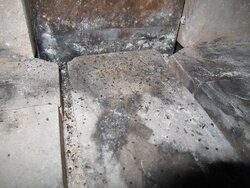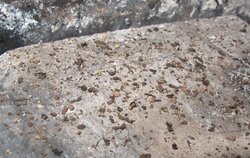I did a search for "creosote" and read them all but still feel like I need to ask:
This is my first year/shoulder. Running an Englander 13, flex liner about 35+', no rain cap as I've got real old clay chimney pots, liner comes up to about 20" (so I've been told} of the top of the pot; pot sits on brick chimney that's about 5' tall. The whole thing has pour in perlite insulation.
Wood I'm burning has been sitting stacked since last Feb or so and the MC says it's anywhere from 9-17% moisture on fresh split face, mixed batch of woods cherry, locust, elm and a little oak. I got this stuff cheap off several CL posts as soon as I learned that lining the chimney was a go; the biggest haul was gray and had checked/cracked ends. ...I know, it doesn't really mean much unless I know, for sure, that it's been s/s for a year+, but this is the best I could do. I am planning on buying a cord of kiln dried from a reputable dealer as winter sets in and leaving the other wood to sit for the next season.
So, I've only had 10-15 fires, tops, and have burned "hot," i.e., stove top thermometer is reading 600-700. I bought two SootEaters recently from Northline. I wanted to see what, if anything, was on the flue before I start burning more frequently and longer. Yesterday I did a bottom up cleaning and this is what I got (see pics/one is an extreme close-up); it's a teaspoon, at best, and it seemed that the bulk of it came down from up high in the flue. I was expecting dust, but got what looks like crunchy mouse turds, although, really, they are no more than 1/32 - 1/8" width. Thoughts?
Questions about creosote and other stuff:
1. Assuming the wood is dry (15% or less), does creosote form as the fire dies down and the stove top temp drops?
2. Same question, but in reverse, is there creosote production as the fire gets going?
3. If the wood is not perfect, aside from not burning it, is there a way to prevent creosote from forming.
4. Where's the best place to put the thermometer on the 13NC?
5. How many split pieces of wood are you 24/7 burners going through in a day? I figure most winter weekend I'm going to be burning all day (but not overnight). Just trying to figure out how much wood I'll need, as I do not want to run out in February....(!)
More to come sometime soon, I'm sure, but would love thoughts on these things.
Alina -enjoying the cold and snow at 76deg in the house!
This is my first year/shoulder. Running an Englander 13, flex liner about 35+', no rain cap as I've got real old clay chimney pots, liner comes up to about 20" (so I've been told} of the top of the pot; pot sits on brick chimney that's about 5' tall. The whole thing has pour in perlite insulation.
Wood I'm burning has been sitting stacked since last Feb or so and the MC says it's anywhere from 9-17% moisture on fresh split face, mixed batch of woods cherry, locust, elm and a little oak. I got this stuff cheap off several CL posts as soon as I learned that lining the chimney was a go; the biggest haul was gray and had checked/cracked ends. ...I know, it doesn't really mean much unless I know, for sure, that it's been s/s for a year+, but this is the best I could do. I am planning on buying a cord of kiln dried from a reputable dealer as winter sets in and leaving the other wood to sit for the next season.
So, I've only had 10-15 fires, tops, and have burned "hot," i.e., stove top thermometer is reading 600-700. I bought two SootEaters recently from Northline. I wanted to see what, if anything, was on the flue before I start burning more frequently and longer. Yesterday I did a bottom up cleaning and this is what I got (see pics/one is an extreme close-up); it's a teaspoon, at best, and it seemed that the bulk of it came down from up high in the flue. I was expecting dust, but got what looks like crunchy mouse turds, although, really, they are no more than 1/32 - 1/8" width. Thoughts?
Questions about creosote and other stuff:
1. Assuming the wood is dry (15% or less), does creosote form as the fire dies down and the stove top temp drops?
2. Same question, but in reverse, is there creosote production as the fire gets going?
3. If the wood is not perfect, aside from not burning it, is there a way to prevent creosote from forming.
4. Where's the best place to put the thermometer on the 13NC?
5. How many split pieces of wood are you 24/7 burners going through in a day? I figure most winter weekend I'm going to be burning all day (but not overnight). Just trying to figure out how much wood I'll need, as I do not want to run out in February....(!)
More to come sometime soon, I'm sure, but would love thoughts on these things.
Alina -enjoying the cold and snow at 76deg in the house!



